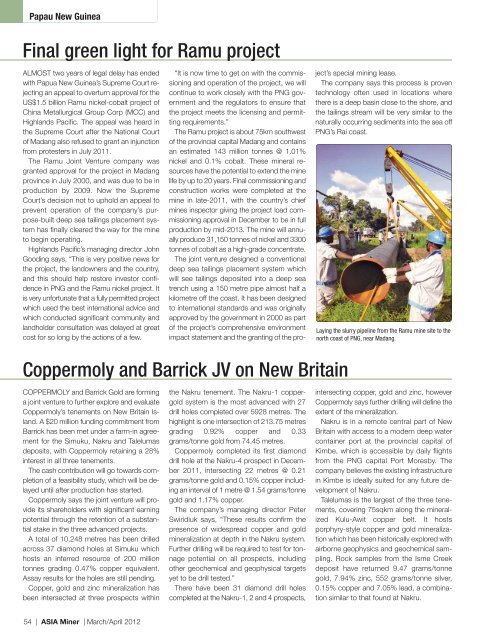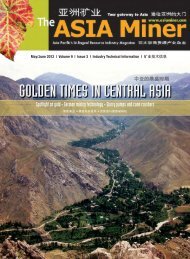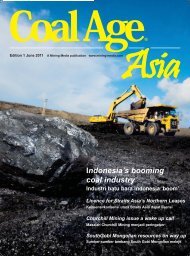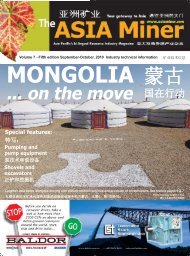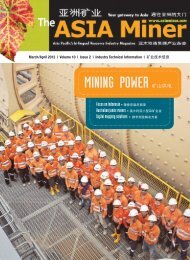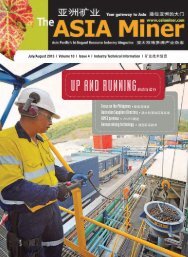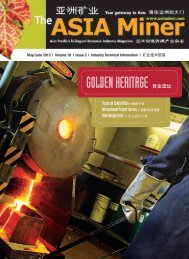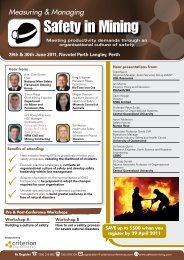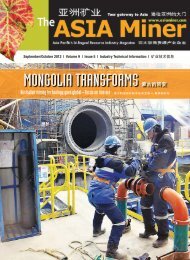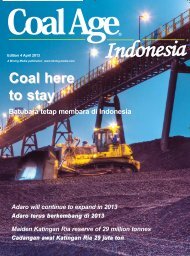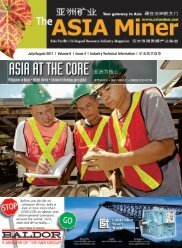Volume 9 Edition 2 2012 - The ASIA Miner
Volume 9 Edition 2 2012 - The ASIA Miner
Volume 9 Edition 2 2012 - The ASIA Miner
Create successful ePaper yourself
Turn your PDF publications into a flip-book with our unique Google optimized e-Paper software.
Papau New Guinea<br />
Final green light for Ramu project<br />
ALMOST two years of legal delay has ended<br />
with Papua New Guinea’s Supreme Court rejecting<br />
an appeal to overturn approval for the<br />
US$1.5 billion Ramu nickel-cobalt project of<br />
China Metallurgical Group Corp (MCC) and<br />
Highlands Pacific. <strong>The</strong> appeal was heard in<br />
the Supreme Court after the National Court<br />
of Madang also refused to grant an injunction<br />
from protesters in July 2011.<br />
<strong>The</strong> Ramu Joint Venture company was<br />
granted approval for the project in Madang<br />
province in July 2000, and was due to be in<br />
production by 2009. Now the Supreme<br />
Court’s decision not to uphold an appeal to<br />
prevent operation of the company’s purpose-built<br />
deep sea tailings placement system<br />
has finally cleared the way for the mine<br />
to begin operating.<br />
Highlands Pacific’s managing director John<br />
Gooding says, “This is very positive news for<br />
the project, the landowners and the country,<br />
and this should help restore investor confidence<br />
in PNG and the Ramu nickel project. It<br />
is very unfortunate that a fully permitted project<br />
which used the best international advice and<br />
which conducted significant community and<br />
landholder consultation was delayed at great<br />
cost for so long by the actions of a few.<br />
“It is now time to get on with the commissioning<br />
and operation of the project, we will<br />
continue to work closely with the PNG government<br />
and the regulators to ensure that<br />
the project meets the licensing and permitting<br />
requirements.”<br />
<strong>The</strong> Ramu project is about 75km southwest<br />
of the provincial capital Madang and contains<br />
an estimated 143 million tonnes @ 1.01%<br />
nickel and 0.1% cobalt. <strong>The</strong>se mineral resources<br />
have the potential to extend the mine<br />
life by up to 20 years. Final commissioning and<br />
construction works were completed at the<br />
mine in late-2011, with the country’s chief<br />
mines inspector giving the project load commissioning<br />
approval in December to be in full<br />
production by mid-2013. <strong>The</strong> mine will annually<br />
produce 31,150 tonnes of nickel and 3300<br />
tonnes of cobalt as a high-grade concentrate.<br />
<strong>The</strong> joint venture designed a conventional<br />
deep sea tailings placement system which<br />
will see tailings deposited into a deep sea<br />
trench using a 150 metre pipe almost half a<br />
kilometre off the coast. It has been designed<br />
to international standards and was originally<br />
approved by the government in 2000 as part<br />
of the project’s comprehensive environment<br />
impact statement and the granting of the project’s<br />
special mining lease.<br />
<strong>The</strong> company says this process is proven<br />
technology often used in locations where<br />
there is a deep basin close to the shore, and<br />
the tailings stream will be very similar to the<br />
naturally occurring sediments into the sea off<br />
PNG’s Rai coast.<br />
Laying the slurry pipeline from the Ramu mine site to the<br />
north coast of PNG, near Madang.<br />
Coppermoly and Barrick JV on New Britain<br />
COPPERMOLY and Barrick Gold are forming<br />
a joint venture to further explore and evaluate<br />
Coppermoly’s tenements on New Britain Island.<br />
A $20 million funding commitment from<br />
Barrick has been met under a farm-in agreement<br />
for the Simuku, Nakru and Talelumas<br />
deposits, with Coppermoly retaining a 28%<br />
interest in all three tenements.<br />
<strong>The</strong> cash contribution will go towards completion<br />
of a feasibility study, which will be delayed<br />
until after production has started.<br />
Coppermoly says the joint venture will provide<br />
its shareholders with significant earning<br />
potential through the retention of a substantial<br />
stake in the three advanced projects.<br />
A total of 10,248 metres has been drilled<br />
across 37 diamond holes at Simuku which<br />
hosts an inferred resource of 200 million<br />
tonnes grading 0.47% copper equivalent.<br />
Assay results for the holes are still pending.<br />
Copper, gold and zinc mineralization has<br />
been intersected at three prospects within<br />
the Nakru tenement. <strong>The</strong> Nakru-1 coppergold<br />
system is the most advanced with 27<br />
drill holes completed over 5928 metres. <strong>The</strong><br />
highlight is one intersection of 213.75 metres<br />
grading 0.92% copper and 0.33<br />
grams/tonne gold from 74.45 metres.<br />
Coppermoly completed its first diamond<br />
drill hole at the Nakru-4 prospect in December<br />
2011, intersecting 22 metres @ 0.21<br />
grams/tonne gold and 0.15% copper including<br />
an interval of 1 metre @ 1.54 grams/tonne<br />
gold and 1.17% copper.<br />
<strong>The</strong> company’s managing director Peter<br />
Swiridiuk says, “<strong>The</strong>se results confirm the<br />
presence of widespread copper and gold<br />
mineralization at depth in the Nakru system.<br />
Further drilling will be required to test for tonnage<br />
potential on all prospects, including<br />
other geochemical and geophysical targets<br />
yet to be drill tested.”<br />
<strong>The</strong>re have been 31 diamond drill holes<br />
completed at the Nakru-1, 2 and 4 prospects,<br />
intersecting copper, gold and zinc, however<br />
Coppermoly says further drilling will define the<br />
extent of the mineralization.<br />
Nakru is in a remote central part of New<br />
Britain with access to a modern deep water<br />
container port at the provincial capital of<br />
Kimbe, which is accessible by daily flights<br />
from the PNG capital Port Moresby. <strong>The</strong><br />
company believes the existing infrastructure<br />
in Kimbe is ideally suited for any future development<br />
of Nakru.<br />
Talelumas is the largest of the three tenements,<br />
covering 75sqkm along the mineralized<br />
Kulu-Awit copper belt. It hosts<br />
porphyry-style copper and gold mineralization<br />
which has been historically explored with<br />
airborne geophysics and geochemical sampling.<br />
Rock samples from the Isme Creek<br />
deposit have returned 9.47 grams/tonne<br />
gold, 7.94% zinc, 552 grams/tonne silver,<br />
0.15% copper and 7.05% lead, a combination<br />
similar to that found at Nakru.<br />
54 | <strong>ASIA</strong> <strong>Miner</strong> | March/April <strong>2012</strong>


